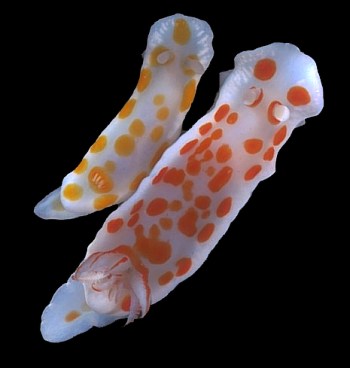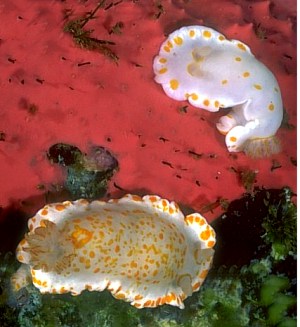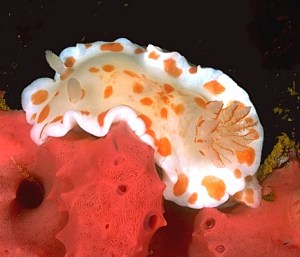
Chromodoris tasmaniensis
Bergh, 1905
Order: NUDIBRANCHIA
Suborder: DORIDINA
Superfamily: EUDORIDOIDEA
Family: Chromodorididae
DISTRIBUTION
SE Australia from New South Wales, Victoria, Tasmania, South Australia.
PHOTO
UPPER RIGHT: New South Wales colour form - Jibbon Head, Port Hacking, NSW, 20m, October, 1981, 21, 28mm long alive. Note the mantle glands showing as opaque white streaks around the anterior end of the mantle. LOWER LEFT: Southern colour form - Blackman's Beach, Hobart, southern Tasmania, February 1984, 24, 41mm long alive. On food sponge Darwinella gardneri. LOWER RIGHT:Goat Island Beach, Ulverstone, northern Tasmania, February 1984, 22, 34mm long alive. On food sponge Darwinella gardneri.
PHOTOS: Bill Rudman.
This is one of the many species of chromodorid in southeastern Australia with a colour pattern of red spots. Chromodoris tasmaniensis is characterised by a white body and mantle, with scattered red or orange spots. The rhinophore clubs are translucent white and the gills are translucent white with red or orange edgeing. Throughout its range the colour of the spots varies from red to light orange in different specimens. In New South Wales specimens the spots are large and while there can be a row of spots around the mantle edge they are part of an irregular scattering of spots all over the mantle. By comparison, specimens from Tasmania (and also Victoria and South Australia) have a distinct row of spots around the edge of the mantle. There are either few spots in the centre of the mantle, or many, but in all cases the outer band of spots is clearly defined.
Throughout its range C. tasmaniensis is usually associated with the reddish-pink food sponges Darwinella gardneri and Darwinella cf. australiensis. In New South Wales the chromodorid most similar in size, shape and colour to C. tasmaniensis is C. splendida, which also feeds on Darwinella cf. australiensis and is endemic to New South Wales. In southern Australia the most similar chromodorid is C. epicuria which also feeds on Darwinella gardneri and is endemic to Tasmania, Victoria and South Australia. Chromodoris splendida has large red spots (Rudman l983) scattered all over the mantle while C. epicuria has orange spots most of which are concentrated in a band around the mantle edge. Chromodoris tasmaniensis then has two colour forms, each within a discrete geographic range. Within each of the two ranges there is an endemic species of Chromodoris feeding on the same sponge which is extremely similar in colour and shape to the local colour form of C. tasmaniensis. I have discussed the possibility that these groups of similarly coloured species represent complex examples of mimicry (Rudman, 1991). See also the page on red spotted species.
References:
•Rudman, W.B. (1983 ) The Chromodorididae (Opisthobranchia: Mollusca) of the Indo-West Pacific: Chromodoris splendida, C. aspersa and Hypselodoris placida colour groups. Zoological Journal of the Linnean Society, 78: 105-173.
•Rudman, W.B. (1987a) The Chromodorididae (Opisthobranchia: Mollusca) of the Indo-West Pacific: Chromodoris epicuria, C. aureopurpurea, C. annulata, C. coi and Risbecia tryoni colour groups. Zoological Journal of the Linnean Society, 90: 305-407.
•Rudman, W.B. (1991) Purpose in Pattern: the evolution of colour in chromodorid nudibranchs. Journal of Molluscan Studies, 57, (T.E. Thompson Memorial Issue): 5-21.


Rudman, W.B., 1999 (October 11) Chromodoris tasmaniensis Bergh, 1905. [In] Sea Slug Forum. Australian Museum, Sydney. Available from http://www.seaslugforum.net/factsheet/chrotasm
Related messages
-
Chromodoris tasmaniensis from Bruny Island
From: Julie Marshall, January 8, 2007 -
Chromodoris tasmaniensis from Botany Bay
From: Nicholas Missenden, June 9, 2005 -
Aggregation of Chromodoris tasmaniensis
From: Ron Greer, March 25, 2005 -
Chromodoris tasmaniensis from Sydney
From: Allan Saben, February 8, 2003 -
Chromodoris tasmaniensis from Sydney
From: Ian Simpson, December 9, 2002 -
Chromodoris tasmaniensis I presume
From: Des Paroz, October 24, 1999 -
Food of Chromodoris tasmaniensis
From: Bill Rudman, October 13, 1999 -
Chromodoris tasmaniensis & C. epicuria in SE Australia
From: Bill Rudman, October 13, 1999
